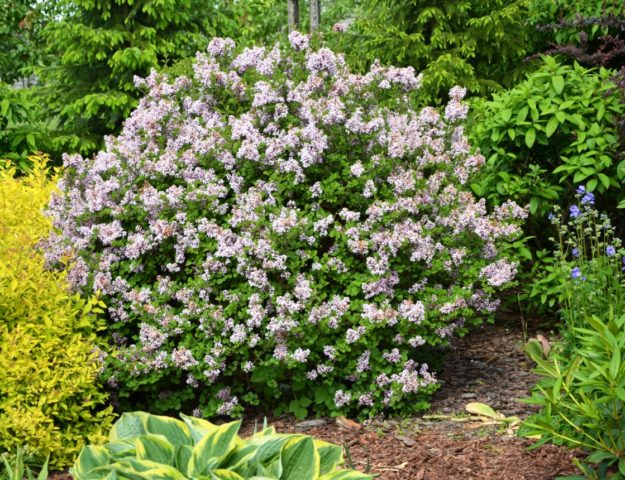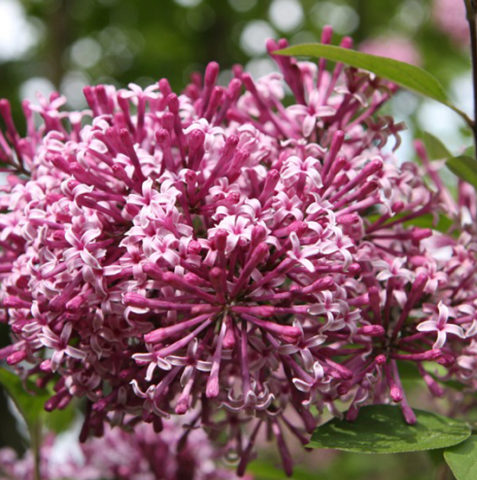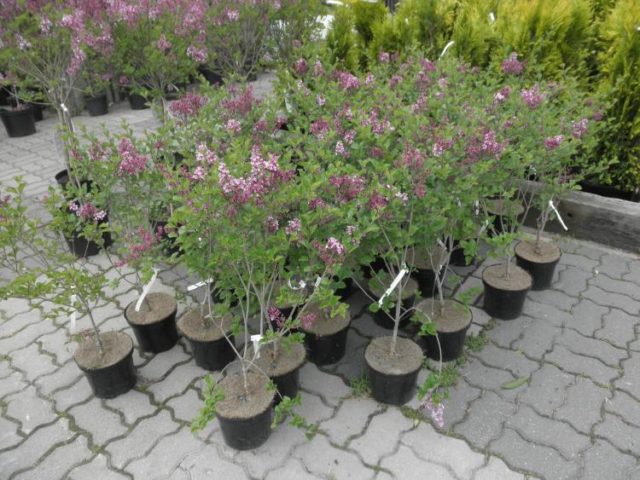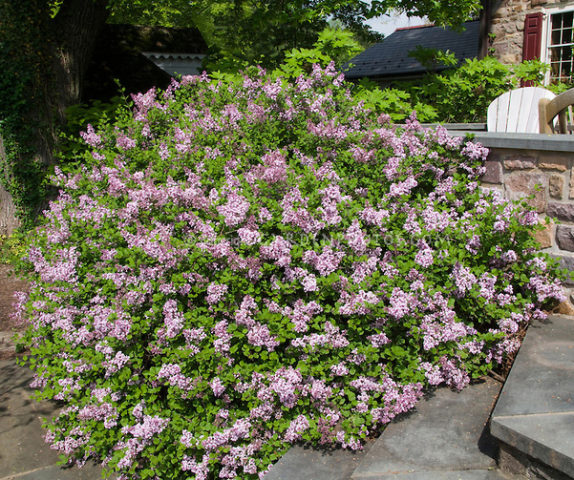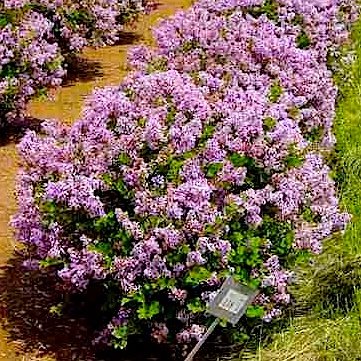Content
When Meyer's dwarf lilac first appeared on the market, it made a real revolution in the minds of people. After all, it has now become possible to grow lilacs in the smallest areas and even in containers and balcony boxes. But Meyer's lilac Palibin broke all popularity records. After all, this is the smallest representative of the already not the most gigantic species of Meyer's lilac.
Description of the variety
Among all varieties of Meyer's lilac, Palibin is distinguished by the smallest size. This baby usually reaches a height of no more than 60-80 cm. Although in some particularly favorable conditions it can grow up to 100 cm. But his growth rate is also very slow. For a year, the length of the branches is good if it increases by 5-8 cm. But it is capable of blooming at a fairly young age, being a very small bush, literally 20-30 cm in height.
Even without special pruning, Mayer's lilac variety Palibin forms an attractive rounded crown that spreads in breadth up to 1.5 m. The branches are brown, which eventually brightens and becomes more gray. Small and shiny oval-heart-shaped leaves densely cover rather long branches. On the reverse side, they have a lighter color.
Inflorescences look like elongated cone-shaped columns, 8-10 cm long. The lilac buds of Meyer Palibin have a rich dark purple hue, clearly visible in the photo, which, when blooming, changes to pink-purple.
But by the end of the flowering period, the color of the flowers fades slightly and turns into light purple. Palibin lilac flowers have an eye-catching, charming scent that is difficult to pass by without noticing it.
Depending on how early or late the spring was, Mayer Palibin's lilac bloom may come in late May or as early as June.
The plants of this variety have a very compact and shallow root system, so they can be easily grown in almost any container and even in a balcony box. But it should be understood that in winter, the soil in any container or box freezes much easier and faster than in the ground. Therefore, containers are usually brought in for the winter period in a practically frost-free room or buried in the garden for the winter. It is usually not so easy to remove the balcony boxes, so they need to be additionally insulated or to provide an additional heating system on especially frosty days, where the Palibin lilac plants will winter.
By the way, among the characteristics of this variety, one can note good resistance to smoke and air pollution. This fact is an additional plus for growing Meyer Palibin lilacs in an urban setting.
The frost resistance of the lilac bushes of this variety is also noteworthy. They will completely survive frosts in the winter period up to - 28-30 ° C. But due to the shallow root system, the soil surface around the bushes needs additional insulation and maintenance of a constant snow cover in winter.
In general, unpretentiousness to a variety of conditions was one of the reasons for the special popularity of this variety of lilacs. Palibin can be called a heat-resistant variety. And it can even do without regular watering.Unpretentiousness to the soil helps to grow it almost anywhere on the site. True, like most lilacs, Palibin is not indifferent to sunlight.
This variety is also famous for its remontability. That is, lilac bushes are able to bloom again around August and September. Usually, the flowers that form at this time are not so numerous. However, a lot here depends, first of all, on the timely removal of drying out flowers in the spring flowering period.
Reproduction methods
Meyer's Lilac Palibin can be propagated using the following methods:
- seeds;
- cuttings;
- layering;
- root suckers;
- vaccinations.
The first and last methods are quite complex and can be left to professionals. And for ordinary gardeners, the three remaining methods are fine.
Meyer Palibin lilac cuttings are usually cut during the period that coincides with flowering. But at the same time, you should choose branches on which both buds and flower buds are absent. The branches are cut into cuttings no more than 20-25 cm long. Each of them should have at least 2-3 buds. The lower cut is made obliquely, treated with a growth stimulant and stuck into a light moist substrate to a depth of 2-3 cm. It can consist of sand or vermiculite. To preserve moisture, you can build a small makeshift greenhouse on top. Roots usually appear towards the end of summer and autumn. If possible, it is better to keep the rooted cuttings in a frost-free room before planting in a permanent place next season. Cuttings of Palibin lilacs can bloom next year, as in the photo.
You can leave rooted cuttings in the ground, thoroughly insulating them for the winter.
For propagation by layering, it is necessary to choose one of the lilac shoots that are closest to the ground. In the spring it is pressed to the ground, sprinkled with earth and watered regularly throughout the summer. By autumn, roots appear at the point of contact with the ground. The plant can be separated from the mother bush and planted separately.
Reproduction by root suckers is one of the easiest ways. True, provided that the lilac is originally rooted, and not grafted. Otherwise, when separating the root processes, you can get not the desired variety, but the one to which the graft was made. By the way, Meyer's lilac, unlike ordinary lilac, gives root shoots with great difficulty. Therefore, one should not pin great hopes on this method.
Planting and caring for Palibin lilacs
Due to the undemanding plants, planting and caring for Meyer Palibin lilacs can be easily carried out even by a novice gardener.
When to plant
The ideal period for planting Meyer's lilacs is the end of summer, August or September. In any case, you need to wait for cool, and most importantly, cloudy weather. Or timed the process in the evening.
Site selection and soil preparation
As has been mentioned many times, Meyer Palibin's lilac will be able to survive almost anywhere it is planted. But this plant is planted for the sake of abundant flowering, and it can only be expected in a sunny place. If you have to plant lilacs in a depression where water can stagnate, then during planting it is necessary to provide a drainage layer, at least 10-15 cm.
The soil does not require special preparation. The only exceptions are completely depleted, very acidic or saline soils.
- In the first case, when planting, you need to add humus and a certain amount of long-lasting fertilizers.
- In the second case, add chalk or lime.
- In the latter version, a special mixture of humus, turf soil and sand is prepared in equal proportions to fill the planting pit.
How to plant
If lilac seedlings with an open root system are used, then a day before planting they must be soaked in water, and then inspect all the roots. If there are diseased or damaged roots, they are cut to a healthy place. Too long roots are slightly shortened.
Seedlings of lilac Meyer Palibin with a closed root system do not require any additional processing. They are simply placed in a hole slightly larger than the volume of the roots and sprinkled with planting mixture. Then watering is carried out, the earth is compacted around the trunk and covered with mulch with a layer of 5 cm.
Care rules
Taking care of Meyer Palibin's lilacs is not at all difficult.
Watering the culture is necessary only in the first months after planting, if the weather is dry, so that it takes root well. In the future, attention is paid to watering only during the flowering of lilacs. The rest of the time, she will cope quite well with the help of natural moisture.
Regular fertilization will not bring much benefit either. They can only cause lush growth of greenery to the detriment of flowering. You can feed the bushes every two years: in early spring and immediately after the end of spring flowering.
But the Palibin lilac plants will respond with great gratitude to the regular mulching of the land space around the bushes. This will protect them from weed infestation, and retain moisture at the roots, and provide extra nutrients.
As for pruning, it is imperative to remove wilted inflorescences. Only in this case, you can count on repeated abundant flowering. Sanitary pruning should also be regular, that is, removing thickening, broken and unsightly-looking branches.
Meyer Palibin's lilac looks very beautiful on a trunk. In this case, the shape of the trunk must be regularly maintained. After all, fresh buds will constantly appear on the trunk, which will need to be removed. And in the upper part of the crown, its shape is maintained by regularly shortening the ends of the shoots in early spring.
Meyer Palibin's lilac winters very well and can freeze slightly only in snowless and especially frosty winters. But at the same time it quickly recovers.
Diseases and pests
Meyer's Lilac Palibin shows good disease and pest resistance. Nevertheless, in the spring, before bud break, it can be preventively treated with medicinal preparations.
When insect pests appear (lilac hawk moth, kidney mite, moth), the bushes are sprayed with any insecticide suitable for the instructions.
Lilac Palibin in landscape design
Professional designers are very fond of using Palibin lilacs in creating a variety of compositions. This plant can be used both in curbs and hedges. Moreover, to add a colorful accent or to get a spectacular flowering fence.
It will look good in single or combined groups, in flower beds, in rockeries.
Meyer Palibin lilacs can be used to decorate a courtyard, terrace or veranda by planting it in separate containers. It has also been mentioned about the use of this miniature flowering shrub to decorate balconies.
In cities, Palibin lilacs are often used for landscaping playgrounds, recreation areas, school gardens, and city yards.
Looks good against the background of conifers, as well as in the vicinity of honeysuckle, barberry, hydrangea, tree peony.
Conclusion
Miniature and fragrant lilac Meyer Palibin will be a welcome guest on any site in any conditions. Rarely in any other plant you can find a combination of so many advantages at the same time.
Testimonials
Reviews of Meyer's Palibin lilacs are consistent with the popularity of this unpretentious variety.
